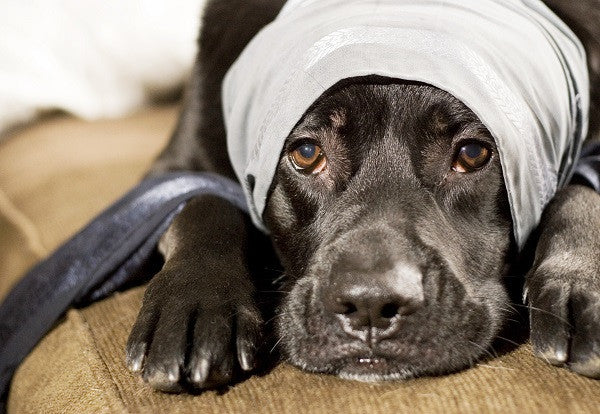
Don't Let Dog Skin Cancer Affect Your Dog
Share

Many pet owners are unaware that their furry friends can get cancer too. It is the last thing pet owners are thinking of when cuddling up with their new puppy.
That's a scary thought when you consider than one in four dogs will develop some kind of cancer with dog skin cancer right at the top of the list. Being correctly informed can increase your chances of avoiding this later on in your pet's life.
According to pet magazine, The Bark, early diagnosis and treatment are key for a better chance of survival and increasing quality of life.
Recognizing the signs of dog skin cancer will give you an indication of when it's time to see a vet. It is always better to be safe than sorry when it comes to our furry companions.
Types of dog skin cancers
The most obvious sign of skin cancer is a growth or tumor, but before you panic, only 20 to 30% of them will turn out to be malignant.
Natural Dog Health Remedies reports that it's fairly easy to tell the difference between malignant and benign conditions.
Benign growths are usually well defined, won't grow much, and don't cause any pain.
The most common examples of these kinds of tumors are lipomas or fatty tumors, which don't need to be removed unless they're causing mobility issues. There are also papillomas, also sometimes called dog warts and melanomas. 85% of melanomas will turn out to be benign.
Benign growths can easily be tested if you're concerned or if they change shape.
There are four common types of malignant dog skin cancers:
- Squamous cell carcinoma commonly appears in a light skinned area with little hair, like your dog's tummy, as sores that won't heal.
- Mast cell tumors look like lipomas, but they're almost always fatal. If you notice fatty tumors around your dog's armpit area, mammary tissue, groin, anus or genital areas, in the lips, eyelids, or body openings, it's best to get it checked out.
- While Hemangiosarcoma more commonly starts in the spleen, it does occasionally present as skin cancer either on or beneath the skin. Look out for soft, firm masses with ulceration or dark, raised skin lesions.
- Fibrosarcoma mostly affects older male dogs, starting at their skull, spine, pelvis and ribs before growing towards the skin like tentacles.
Different breeds are more susceptible to certain types of cancers. Ask your vet which types you should be checking for.
Other signs and symptoms:
Besides checking your pooch's skin as regularly as once a month for any funny growths, there are more urgent signs your pet could be in trouble.
Veterinary oncologist Dr. Nicole Leibman says masses may become uncomfortably itchy, making excessive scratching a sign that something's up.
As dog skin cancer progresses and spreads to other parts of the body, Natural Dog Health Remedies says you may notice enlarged lymph nodes, loss of appetite, vomiting or diarrhea, general weakness or tiredness and maybe even coughing.
The Bark adds bad smells, difficulty breathing, difficulty chewing and bleeding or discharge from any opening on the body to the list.
Treatment options
According to PetMD, treatment will depend on the type of dog skin cancer, the size of the tumor and where on the body it's located.
Small tumors that have not yet spread could be treated with a light therapy called photodynamic therapy, a freezing technique called cryosurgery, or by surgically removing it.
Larger tumors are usually removed surgically along with the tissue around the tumor. In severe cases, this may mean amputation.
When tumors can't be removed entirely, or if it would be impractical to do so, your vet may suggest chemotherapy or radiation. These 2 options can have good results, but chance of recurrence is always there. Not to mention these 2 options can cause quite a bit of stress to your beloved sick pet. The side effects of chemo and radiation therapy can greatly decrease the quality of life and this is something that should be taken into consideration when selecting options. Please ask your vets any questions that you may have.
Traditional dog skin cancer treatments are expensive and while it's always advisable to seek a veterinarian's advice, there are alternative treatment options you could try.
Holistic treatments and traditional remedies like acupuncture, massage, hydrotherapy and magnetic field therapy are more affordable and can help fight the disease and the
Another option is to consider a diet change for your pet. While little can be done to fight aggressive cancer, a change in diet might help improve the quality and lengthen the life of your furry friend.
Processed dog food is packed with grains with very little nutritional value. Instead, your dog should be eating more meat and very little carbohydrates. The cost for a more natural diet is higher than eating processed dog food, but the value will pay back dividends in the form of health.
Lysine found in cottage and ricotta cheeses buffer the acid found in cancer cells, slowing their growth. Combining this with fish oils will help slow them from spreading.
Cancer cells thrive in acidic environments, so adding an alkaline supplement to your dog's diet may help as well.
Protective measures
UV exposure is the number one cause of dog skin cancer, especially for animals with light-coloured skin and fur.
The best way to protect your furry friend is to use sunscreen. Just make sure it doesn't contain zinc oxide.
Dr. Leibman explains that accidentally ingesting zinc oxide can cause your pet severe anemia. Human sunscreens are safe to use, as long as they don't have this as an ingredient. Choose a brand that dries fast and is water resistant. Make sure to cover your pet's skin where their fur is thinnest.
PetMD suggests limiting the amount of time your pooch spends in the sun, especially between 10 am and 2 pm, while another veterinary oncologist Dr. Anne Hohenhaus suggests investing in sun-protective clothes and goggles.
She adds it's important to make sure that pets have access to a shaded area when left alone and to keep an eye on broken toenails which are often associated with melanoma.
There's been talk of the idea of tattooing or injecting ink into the noses of animals with light skin to help protect against dog skin cancer. However, there's no evidence yet to prove it works.
The last word on dog skin cancer
Early detection is your best defense against dog skin cancer and could save your best friend's life.
Check your buddy's body as often as possible and don't hesitate to book a visit with a vet if your notice any lump, bump or mark that's out of place.
The Yunnan Baiyao store have a helpful list of resources to help you choose the best treatment for your four-legged loved one.
